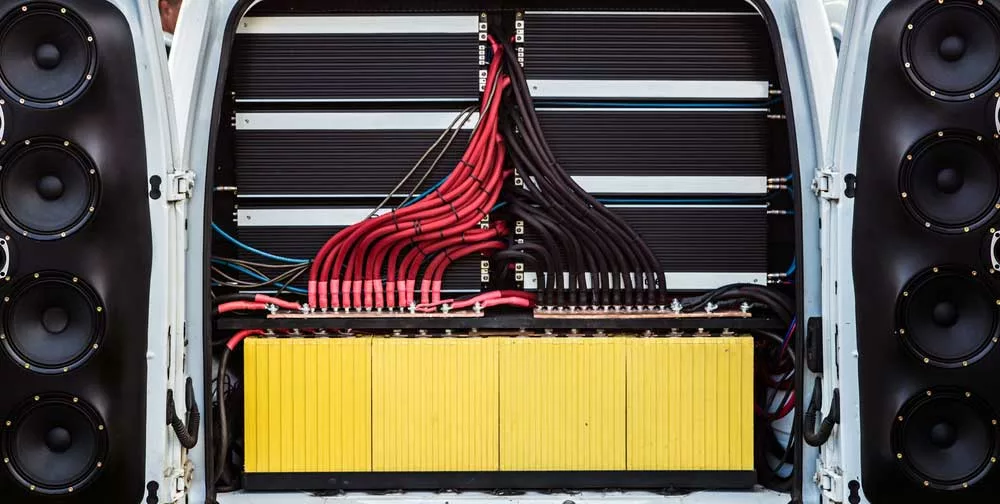Best Way to Wire Dual Voice Coil Sub, Many people are swapping single voice coil subwoofers for dual voice coil speakers.
However, it can be tasking when wiring the setup. Also, wiring the speakers incorrectly can lead to low power or sound from your stereo system.
Therefore, what is the Best Way to Wire Dual Voice Coil Sub? This article will help you learn.
Table of Contents
- What is a dual voice coil speaker?
- Dual voice coil subwoofer advantages
- Choosing and matching a dual voice coil speaker to your amplifier effectively
- How to wire dual voice coil speakers in series
- How to Wire a Dual Voice Coil Subwoofers in Parallel
- Series and Parallel Wiring
- Parallel Vs. Series Impedance Loads
- Conclusion
What is a dual voice coil speaker?
A dual voice coil speaker uses two wires that coil around a bobbin within the speaker’s magnet.
Ordinary single-coil speakers have one coil winding inside the magnet.
How are dual voice coil and single voice coil subwoofers different?
Single voice coil subwoofers use one set of coil windings wrapped in a magnet, while dual voice coils subwoofers have two wire coils.
Dual voice coil subwoofers also use two pairs of wire leads and terminals that connect to the amplifier.
A single coil subwoofer uses one pair of wire leads and positive and negative terminals for connection.
How do dual and single voice coil speakers differ in their performance?
You will find variations in performance aspects, mainly their magnets’ strength, power handling capability, and frequency range.
Regarding magnetic strength, dual voice coil speakers are more robust than single voice coils subs.
The double coil winding makes the magnet strong.
Dual voice coil speakers can handle more power compared to single voice coils.
For example, a 2 Ohm DVC speaker can take power output from an 8 Ohm amplifier in parallel wiring.
A 2 Ohm single coil speaker is limited to handling power from an amplifier with 2 Ohms or less.
The double voice coil speakers also offer a higher frequency range, making them more efficient than single voice coil speakers.
Single vs. dual voice coil subwoofer, which is better?
DVC speakers are better than single voice coil speakers as they handle more power, have a higher frequency, and have stronger magnets.
They also have better surround sound quality.
Dual voice coil subwoofer advantages
The following are some reasons why subwoofers with twin voice coils are reliable.
Maximize the amplifier power output.
Standard amplifiers are rated for a specified power (in Watts) at a particular speaker load Ohm rating.
For instance, a mono amplifier has the following ratings: 350 W RMS at 4 ohms, 600 W RMS at 2 ohms speaker load, and 1 ohm, 1,000 W RMS.
For instance, you may want to employ one subwoofer and a single (mono) bass configuration.
There are only 2 ohms or higher subwoofers in the market, and the amp will give 600 watts, which is its limit.
While adding a second 2-ohm subwoofer and wiring them in parallel is an option, doing so would require purchasing a larger box, spending more money, requiring more installation space, and so on.
You could achieve the amp’s total output power by wiring a 2-ohm dual voice coil subwoofer in parallel.
Otherwise, you’ll never be able to use the amplifier’s full power potential.
This case is especially relevant nowadays when certain amplifiers can drive a single ohm and have low ratings.
Suitable for Custom Setups and Amplifier Channels

A 4-subwoofer speaker setup in a car’s trunk space.
Bridging may only work with some amplifiers. For instance, if you only have a single 4-channel amplifier, it can be a big issue.
If you want to add a fifth subwoofer, you may have to buy another amplifier which will cost you a lot of money.
With a dual coil subwoofer, you can use one channel for each voice coil that drives more power.
Similarly, single or multiple subwoofers can use one amp for each voice coil for high-power systems.
Multiple Subwoofers/Amplifiers Impedance Matching

Multiple subwoofers and speakers in a car’s front door panels.
Connecting numerous subwoofers most often won’t make them work as a single unit.
If each subwoofer has a different impedance, wiring them together could harm the amplifier.
Wiring two speakers with different impedances in parallel accumulates an impedance as one speaker with twice the ohms.
The sum of the impedances results in a new impedance.
For instance, two parallel-connected speakers with an eight ohms impedance have a four ohms impedance.
Therefore, you should connect the subwoofer with the lower impedance to the amplifier if you have two subwoofers with varying impedances.
One example is where one subwoofer has a four-ohm impedance while the other has a two-ohm impedance.
Connect the amplifier to the speaker with the lower impedance.
You can wire the 2-ohm subwoofer parallel to the amp channel that connects the 4-ohm speaker.
They are suitable for home and car stereo systems.
Usually, 8-ohm subwoofers are ineffective for vehicle audio.
The reason is that they cannot output the same amount of power as a speaker with a 4-ohm rating.
Because they fall below the minimum amp specification, car subwoofers with 2 or 4 ohms ratings are incompatible with home stereo amplifiers.
Wiring them together can cause the amplifier to overheat, shut off, or suffer damage.
You might use a dual 4-ohm subwoofer for home and automotive use, but dual voice coil speakers offer particular advantages.
One of the benefits in this situation is achieving an 8-ohms home stereo in a series wiring.
The other is to use a single 4-ohm or two in parallel as a car radio amplifier.
Choosing and matching a dual voice coil speaker to your amplifier effectively
When choosing a dual voice coil subwoofer for your amplifier, the Ohm rating is essential.
The primary Ohm ratings in DVC speakers are 2-Ohm, 4-Ohm, and 8-Ohm speakers.
The number of speakers you will use is essential for choosing the best dual voice coil subwoofer.
Here’s how you should wire the speakers depending on the number of speakers.
The Wiring Illustration of 2 Ohm Dual Voice Coil Subwoofer
Wiring Illustration of 4 Ohm Dual Voice Coil Subwoofer
Wiring Illustration of 8 Ohm Dual Voice Coil Subwoofer
How to wire dual voice coil speakers in series
Step 1. Join the positive lead from the first Voice Coil to your amplifier’s positive speaker output.
Step 2. Link the positive wire lead on the second voice coil to the negative lead wire on the first voice coil.
Step 3. Connect the second voice coil’s negative terminal to the amplifier’s negative output.
Do you need to wire more than two dual voice coil subs in a series setup?

A two-channel vintage amplifier.
Yes. With these steps, you can wire two or more dual voice coil subwoofers in series.
Step 1. Connect the first voice coil’s positive lead to the positive output of the amplifier.
Step 2. Wire the first voice coil’s negative lead to the positive lead of the third voice coil.
Step 3. Connect the second coil’s positive lead to the negative lead of the fourth voice coil.
Step 4. Connect the second coil’s negative lead to the negative output of the amplifier.
Step 5. Connect the negative lead of the third voice coil to the positive lead of the fourth voice coil.
How to Wire a Dual Voice Coil Subwoofers in Parallel
Step 1: Wire the positive leads from the first and second voice coils to the amplifier’s positive output.
Step 2: Join the negative leads of the first and second voice coils to the negative output terminal of the amplifier.
How to wire more than two subwoofers with dual voice coils
When wiring two or more subwoofers to one amp, repeat the same process as a single subwoofer for the extra speakers.
Series and Parallel Wiring
The best way to wire dual voice coil subs is through series or parallel wiring.
Best Way to Wire Dual Voice Coil Sub: Steps for wiring in series
Connecting the speaker coils in series adds more impedance. As you connect each component to another in a single circuit, their combined impedance determines the voltage flow in series connections. Therefore, ensuring the amplifier specifications handle high impedance load is vital.
- Check the impedance of each speaker’s voice coils for amplifier combability.
- Connect the positive wire lead of one voice coil to the negative of the other.
- Connect the wire leads from the positive and negative terminals of the amplifier to the positive and negative leads of the coils.
- Ensure the connections are sturdy without any loose wires.
Best Way to Wire Dual Voice Coil Sub: Steps for wiring in parallel
With parallel wiring, you reduce impedance.
Each speaker receives the same voltage from the amp by connecting subwoofers parallel to an amplifier.
These are the wiring steps.
- First, determine the impedance of the speaker coils and see if they are compatible with your amplifier. The impedance is the difficulty of a speaker to power. A lower impendence ensures an efficient parallel wiring setup.
- Connect the positive terminals of each of the speaker coils together.
- Join the negative terminals of each of the speaker coils to each other.
- Connect the positive wire leads to the positive amplifier output terminal. Join the negative wire leads to the amplifier’s negative output.
- Ensure the connection is firm and the wires are not loose.
Parallel Vs. Series Impedance Loads

Powerful speaker set up with eight speakers, wires, and amplifiers.
The impedance load affects the type of wiring you want for your dual voice coil sub setup.
Here are the steps to determine the impedance loads for both series and parallel configurations.
Best Way to Wire Dual Voice Coil Sub: Series Circuits
The impedance load on a series setup is cumulative. Therefore, the reason why checking the amplifier’s maximum rating is essential.
In a series setup, voltage flows from the positive terminal of the amplifier through each speaker coil before returning to the negative terminal.
If you have four speakers, each with a 4 Ohm rating, the impedance load is 16 Ohms. You get the figure by adding 4 + 4 + 4 + 4, which equals 16.
Best Way to Wire Dual Voice Coil Sub: Parallel Circuits
In parallel wiring setups, the amplifier’s positive current travels along the speaker coils’ positive terminals.
It then reaches the negative terminal of the amplifier through the negative leads of the coils.
Therefore, the impedance is divided equally among the speaker coils.
To calculate the impedance load for four dual coil speakers with a 4 Ohm rating, you divide.
The total load is 1 Ohm, dividing 4 ÷ 4 = 1.
Conclusion
The above guide explains the best way to wire dual voice coil subs.
With the benefits, tips to consider, and how to set up the wiring, your project should be smooth.
